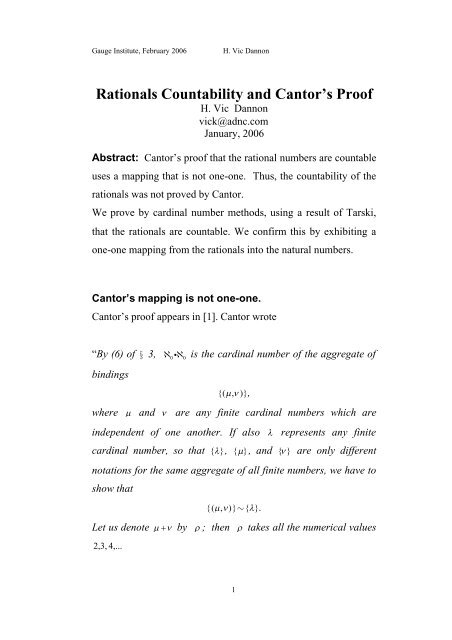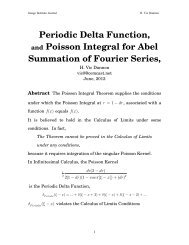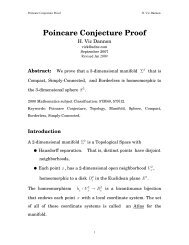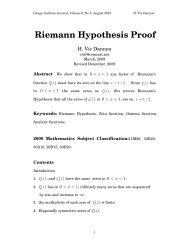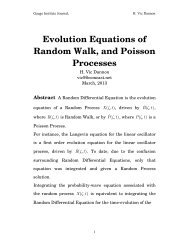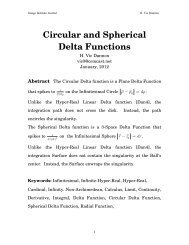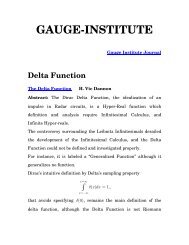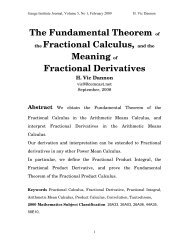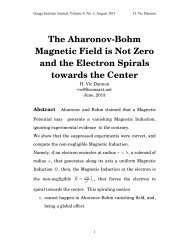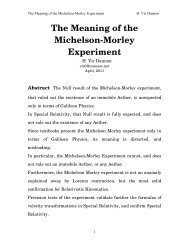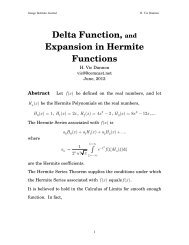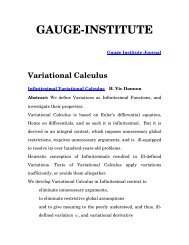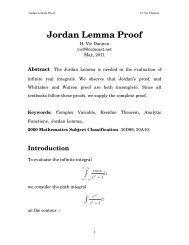Rationals Countability and Cantor's Proof - Gauge-institute.org
Rationals Countability and Cantor's Proof - Gauge-institute.org
Rationals Countability and Cantor's Proof - Gauge-institute.org
Create successful ePaper yourself
Turn your PDF publications into a flip-book with our unique Google optimized e-Paper software.
<strong>Gauge</strong> Institute, February 2006<br />
H. Vic Dannon<br />
<strong>Rationals</strong> <strong>Countability</strong> <strong>and</strong> Cantor’s <strong>Proof</strong><br />
H. Vic Dannon<br />
vick@adnc.com<br />
January, 2006<br />
Abstract: Cantor’s proof that the rational numbers are countable<br />
uses a mapping that is not one-one. Thus, the countability of the<br />
rationals was not proved by Cantor.<br />
We prove by cardinal number methods, using a result of Tarski,<br />
that the rationals are countable. We confirm this by exhibiting a<br />
one-one mapping from the rationals into the natural numbers.<br />
Cantor’s mapping is not one-one.<br />
Cantor’s proof appears in [1]. Cantor wrote<br />
“By (6) of § 3, 0 <br />
0<br />
bindings<br />
is the cardinal number of the aggregate of<br />
{( , )},<br />
where <strong>and</strong> are any finite cardinal numbers which are<br />
independent of one another. If also represents any finite<br />
cardinal number, so that { }, { }, <strong>and</strong> { }<br />
are only different<br />
notations for the same aggregate of all finite numbers, we have to<br />
show that<br />
{( , )} { }<br />
.<br />
Let us denote <br />
by ; then takes all the numerical values<br />
2,3, 4,...<br />
1
<strong>Gauge</strong> Institute, February 2006<br />
H. Vic Dannon<br />
<strong>and</strong> there are in all 1 elements ( , ) for which ,<br />
namely:<br />
(1, 1) , (2, 2) ,…, ( 1,1) .<br />
In this sequence imagine first the element (1,1) , for which 2 ,<br />
put , then the two elements for which 3 , then the three<br />
elements for which 4 ,<br />
<strong>and</strong> so on. Thus, we get all the elements ( , ) in a simple series:<br />
(1,1); (1, 2), (2,1); (1,3) , (2, 2), (3,1); (1, 4), (2,3) ,…,<br />
<strong>and</strong> here, as we easily see, the element ( , ) comes at the th<br />
place, where<br />
The variable<br />
(9)<br />
( 1)( 2)<br />
.<br />
2<br />
takes every numerical value 1,2,3,... , once.<br />
Consequently, by means of (9), a reciprocally univocal relation<br />
subsists between the aggregates { }<br />
<strong>and</strong> {( , )}.”<br />
Clearly, the variable takes several times some of numerical<br />
value 1,2,3,..., The mapping is not one-one.<br />
We have,<br />
1, 1, 1 , <strong>and</strong> (1,1) 1.<br />
1, 2 , 2 , <strong>and</strong> (1, 2) 2 .<br />
2 , 1, 2 , <strong>and</strong> (2,1) 2 .<br />
1 , 3 , 4 , <strong>and</strong> (1,3) 4 .<br />
2 , 2 , 4 , <strong>and</strong> (2, 2) 4.<br />
2
<strong>Gauge</strong> Institute, February 2006<br />
H. Vic Dannon<br />
3, 1, 4 , <strong>and</strong> (3,1) 4.<br />
1, 4 , 7 , <strong>and</strong> (1, 4) 7 .<br />
2 , 3, 7 , <strong>and</strong> (2,3) 7.<br />
3, 2, 7 , <strong>and</strong> (3,2) 7.<br />
4 , 1, 7 , <strong>and</strong> (4,1) 7 .<br />
Apparently, Cantor expected his mapping to be a bijection, did not<br />
check it, <strong>and</strong> did not see that it is not even one-one.<br />
It is well known [2] that a one-one mapping is required to<br />
establish that cardQ<br />
<strong>and</strong> his use of<br />
theory.<br />
cardN<br />
. Thus, Cantor’s claim is unfounded,<br />
2<br />
0 <br />
0<br />
, amounts to adding another axiom to his set<br />
<strong>Proof</strong> of <strong>Rationals</strong> <strong>Countability</strong> by Tarski result.<br />
We use the graphical interpretation of Cantor’s proof by a zig-zag<br />
through an infinite triangular matrix of rationals. While the zigzag<br />
by itself does not prove the countability, it is useful to clarify<br />
our argument:<br />
The first line in the zig-zag has one rational<br />
1/1.<br />
The second line has two rationals,<br />
1/2, <strong>and</strong> 2/1.<br />
………………………………………………<br />
The n-th line has n rationals,<br />
1/n, 2/(n-1),…,(n-1)/2, n/1,<br />
………………………………………………..<br />
3
<strong>Gauge</strong> Institute, February 2006<br />
H. Vic Dannon<br />
1 1 1 1 1<br />
1 2 3 4 5<br />
2 2 2 2<br />
1 2 3 4<br />
3 3 3<br />
1 2 3<br />
4 4<br />
1 2<br />
5<br />
1<br />
<br />
... ... * ... *<br />
... ... ... ... <br />
... ... ... * ... *<br />
... ... ... ... <br />
... ... ... * ... *<br />
... ... ... ... <br />
... ... .... * ... *<br />
... ... ... ... <br />
... ... ... * ... *<br />
... ... ... ...<br />
* ... * ... *<br />
<br />
<br />
...<br />
* ... *<br />
...<br />
<br />
* <br />
<br />
<br />
Summing the number of the rationals along the zig-zag, for<br />
n 1,2,3.... ,<br />
1 2 3 .... n<br />
. (1)<br />
0<br />
Thus,<br />
2(12 3 .... n<br />
) .<br />
0<br />
That is,<br />
Tarski ([3], or [4, p.174]) proved that<br />
for any sequence of cardinal numbers,<br />
cardinal m , the partial sums inequalities<br />
1 2<br />
... n<br />
n<br />
2<br />
n<br />
. (2)<br />
0<br />
m ,<br />
1<br />
m ,<br />
2<br />
m m m m, for n 1,2,3....<br />
imply the series inequality<br />
m m ... m ....<br />
m.<br />
1 2<br />
n<br />
m ,…, <strong>and</strong> a<br />
3<br />
4
<strong>Gauge</strong> Institute, February 2006<br />
H. Vic Dannon<br />
Applying to (1),<br />
Regarding (2), this says<br />
12 3 .... n<br />
...<br />
.<br />
2<br />
0 <br />
0<br />
<br />
0<br />
.<br />
2 2<br />
Since 0 <br />
0<br />
<br />
0, by transitivity of cardinal inequalities [3, p.<br />
147],<br />
Since<br />
2<br />
0 <br />
0<br />
,<br />
2<br />
.<br />
0 0<br />
2<br />
0 <br />
0<br />
.<br />
0<br />
<strong>Proof</strong> of <strong>Rationals</strong> <strong>Countability</strong> by a one-one mapping.<br />
Aided by the zig-zag listing of the rationals, we produce a one-one<br />
mapping from the rationals into the natural numbers. We construct<br />
our mapping with numerical examples. Then we give the general<br />
formula.<br />
The first line in the zig-zag has one rational<br />
which we assign as follows<br />
1<br />
1/ 1<br />
1<br />
1 2 3<br />
1 .<br />
The second line in the zig-zag has two rationals,<br />
1/2, <strong>and</strong> 2/1,<br />
which we assign as follows<br />
1<br />
2<br />
1 2 5<br />
2 ,<br />
5
<strong>Gauge</strong> Institute, February 2006<br />
H. Vic Dannon<br />
2<br />
2<br />
2 2 6<br />
1 .<br />
The third line in the zig-zag has three rationals<br />
3/1, 2/2, 1/3,<br />
which are assigned as follows<br />
3<br />
3<br />
1 2 9<br />
1 ,<br />
2<br />
3<br />
2 2 10<br />
2 ,<br />
1<br />
3<br />
3 2 11<br />
3 .<br />
The fourth line in the zig-zag has four rationals<br />
1/4, 2/3, 3/2, 4/1<br />
which are assigned as follows<br />
1<br />
4<br />
1 2 17<br />
4 ,<br />
2<br />
4<br />
2 2 18<br />
3 ,<br />
3<br />
4<br />
3 2 19<br />
2 .<br />
4<br />
4<br />
4 2 20<br />
1 .<br />
The fifth line in the zig-zag has five rationals<br />
5/1, 4/2, 3/3, 2/4, 1/5,<br />
which are assigned as follows<br />
5<br />
5<br />
1 2 33<br />
1 ,<br />
2<br />
5<br />
2 2 34<br />
4 ,<br />
6
<strong>Gauge</strong> Institute, February 2006<br />
H. Vic Dannon<br />
If<br />
the m n 1 2k<br />
3<br />
5<br />
3 2 35<br />
3 .<br />
2<br />
5<br />
4 2 36<br />
4 .<br />
1<br />
5<br />
5 2 37<br />
5 .<br />
m n 1 even 2k<br />
,<br />
zig-zag line has the 1 2<br />
which are assigned as follows<br />
If<br />
the m n 1 2k<br />
1<br />
m n k<br />
1/n, 2/(n-1),…(n-1)/2, n/1,<br />
1<br />
2<br />
1 2 k<br />
n ,<br />
2<br />
2 2<br />
n 1<br />
2k<br />
…………………….<br />
n<br />
2<br />
1<br />
2k<br />
2k<br />
1 2 ,<br />
n<br />
1<br />
2k<br />
2k<br />
2 .<br />
m n 1 odd 2 k 1,<br />
,<br />
rationals<br />
zig-zag line has the mn 1 2 k 1<br />
rationals<br />
which are assigned as follows<br />
m/1, (m-1)/2,…, 2/(m-1),1/m,<br />
m<br />
1<br />
m<br />
2<br />
2k<br />
1<br />
1 2 ,<br />
1<br />
2k<br />
1<br />
2 2 ,<br />
7
<strong>Gauge</strong> Institute, February 2006<br />
H. Vic Dannon<br />
…………………….<br />
2<br />
2k<br />
2<br />
m 1<br />
1<br />
m<br />
2k<br />
1<br />
2 1<br />
2k<br />
1 2 k <br />
.<br />
This defines a one-one function from the rationals into the natural<br />
numbers.<br />
,<br />
References<br />
[1] Cantor, Ge<strong>org</strong>, Contributions to the founding of the theory of Transfinite<br />
Numbers, p.107. Open Court Publishing 1915, Dover 1955.<br />
[2] Lipschutz, Seymour, Theory <strong>and</strong> problems of Set Theory <strong>and</strong> Related Topics,<br />
McGraw-Hill, 1964.<br />
[3] Tarski, Alfred, Axiomatic <strong>and</strong> algebraic aspects of two theorems on sums of<br />
cardinals, Fundamenta Mathematicae, Volume 35, 1948, p. 79-104. Reprinted in<br />
Alfred Tarski Collected papers, edited by Steven R. Givant <strong>and</strong> Ralph N. McKenzie,<br />
Volume 3, 1945-1957, p. 173, Birkhauser, 1986.<br />
[4] Sierpinski, Waclaw, Cardinal <strong>and</strong> Ordinal Numbers. Warszawa, 2 nd edition,<br />
1965, (Also in the 1958, 1 st edition).<br />
8


